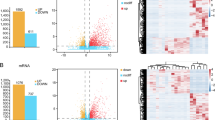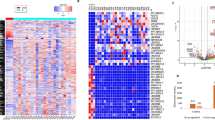Abstract
Long non-coding RNAs (lncRNAs) and their role in competitive endogenous RNA (ceRNA) networks have emerged as fundamental debates in the biological processes of initiation and progression of cancer. This study aimed to identify and measure the expression levels of relevant ceRNA regulatory genes contributing to acute lymphoblastic leukemia (ALL). lncRNA H19 and BCL-2 mRNA were chosen based on in silico studies and their interactions with miR-326. Subsequently, the aforementioned coding/non-coding gene expression profiles were measured using qRT-PCR in 50 bone marrow samples, including 33 cases with pediatric ALL and 17 controls with no evidence of malignancy. lncRNA H19 was identified as an oncogenic factor which was noticeably increased in the newly diagnosed patients (P = 0.0019, AUC = 0.84) and negatively associated with miR-326 (r = −0.6, P = 0.02). Furthermore, a negative correlation was introduced between the transcriptional levels of miR-326 and the anti-apoptotic BCL-2 gene (r = −0.6, P = 0.028). The novel experimental and bioinformatic results achieved in this study may provide new insights into the molecular leukemogenesis of pediatric ALL.





Similar content being viewed by others
Data availability
The authors of this paper assure that data being reported in this research are accurate.
References
Arber DA, Orazi A, Hasserjian R, Thiele J, Borowitz MJ, Le Beau MM, Bloomfield CD, Cazzola M, Vardiman JW (2016) The 2016 revision to the World Health Organization (WHO) classification of myeloid neoplasms and acute leukemia. Blood 127:2391–2405. https://doi.org/10.1182/blood-2016-03-643544
Ding L-W, Sun Q-Y, Tan K-T, Chien W, Thippeswamy AM, Yeoh AEJ, Kawamata N, Nagata Y, Xiao J-F, Loh X-Y (2017) Mutational landscape of pediatric acute lymphoblastic leukemia. Cancer Res 77:390–400
Li W, Jiang P, Sun X, Xu S, Ma X, Zhan R (2016) Suppressing H19 modulates tumorigenicity and stemness in U251 and U87MG glioma cells. Cell Mol Neurobiol 36:1219–1227
Bhan A, Soleimani M, Mandal SS (2017) Long noncoding RNA and cancer: a new paradigm. Cancer Res 77:3965–3981
Cao H, Wahlestedt C, Kapranov P (2018) Strategies to annotate and characterize long noncoding RNAs: advantages and pitfalls. Trends Genet 34:704–721
Cheetham S, Gruhl F, Mattick J, Dinger M (2013) Long noncoding RNAs and the genetics of cancer. Br J Cancer 108:2419
D’Alessandro G, di Fagagna, F.d.A. (2018) Long non-coding RNA in the control of genome stability and cancer phenotypes. Non-coding RNA Invest 2:21–26
Cao J (2014) The functional role of long non-coding RNAs and epigenetics. Biological Proc Online 16:42
Noh JH, Kim KM, McClusky WG, Abdelmohsen K, Gorospe M (2018) Cytoplasmic functions of long noncoding RNAs. Wiley Interdiscip Rev RNA 9:e1471
Tay Y, Rinn J, Pandolfi PP (2014) The multilayered complexity of ceRNA crosstalk and competition. Nature 505:344–352
Ghodousi ES, Rahgozar S (2018) MicroRNA-326 and microRNA-200c: two novel biomarkers for diagnosis and prognosis of pediatric acute lymphoblastic leukemia. J Cell Biochem 119:6024–6032
Gabory A, Jammes H, Dandolo L (2010) The H19 locus: role of an imprinted non-coding RNA in growth and development. Bioessays 32:473–480
Zhang T-J, Zhou J-D, Zhang W, Lin J, Ma J-C, Wen X-M, Yuan Q, Li X-X, Xu Z-J, Qian J (2018) H19 overexpression promotes leukemogenesis and predicts unfavorable prognosis in acute myeloid leukemia. Clin Epigenetics 10:47
Weidle UH, Ruger R (2017) Long non-coding RNAs and their role in metastasis. Cancer Genomics Proteomics 14:143–160
Barsyte-Lovejoy D, Lau SK, Boutros PC, Khosravi F, Jurisica I, Andrulis IL, Tsao MS, Penn LZ (2006) The c-Myc oncogene directly induces the H19 noncoding RNA by allele-specific binding to potentiate tumorigenesis. Cancer Res 66:5330–5337
Raveh E, Matouk IJ, Gilon M, Hochberg A (2015) The H19 Long non-coding RNA in cancer initiation, progression and metastasis—a proposed unifying theory. Mol Cancer 14:184
Huarte M (2015) The emerging role of lncRNAs in cancer. Nat Med 21:1253–1261
Jiao Z, Tian Q, Li N, Wang H, Li K (2018) Plasma long non-coding RNAs (lncRNAs) serve as potential biomarkers for predicting breast cancer. Eur Rev Med Pharmacol Sci 22:1994–1999
Pouyanrad S, Rahgozar S, Ghodousi ES (2019) Dysregulation of miR-335-3p, targeted by NEAT1 and MALAT1 long non-coding RNAs, is associated with poor prognosis in childhood acute lymphoblastic leukemia. Gene 692:35–43
Zhao TF, Jia HZ, Zhang ZZ, Zhao XS, Zou YF, Zhang W, Wan J, Chen XF (2017) LncRNA H19 regulates ID2 expression through competitive binding to hsa-miR-19a/b in acute myelocytic leukemia. Mol Med Rep 16:3687–3693
Meijerink JP, Van Lieshout EM, Beverloo HB, Van Drunen E, Mensink EJ, Macville M, Pieters R (2005) Novel murine B-cell lymphoma/leukemia model to study BCL2-driven oncogenesis. Int J Cancer 114:917–925
Diaz-Flores E, Comeaux EQ, Kim KL, Melnik E, Beckman K, Davis KL, Wu K, Akutagawa J, Bridges O, Marino R (2019) Bcl-2 is a therapeutic target for hypodiploid B-lineage acute lymphoblastic leukemia. Cancer Res 79:2339–2351
Sun C, Huang C, Li S, Yang C, Xi Y, Wang L, Zhang F, Fu Y, Li D (2016) Hsa-miR-326 targets CCND1 and inhibits non-small cell lung cancer development. Oncotarget 7:8341
D’Angelo V, Iannotta A, Ramaglia M, Lombardi A, Zarone M, Desiderio V, Affinita M, Pecoraro G, Di Martino M, Indolfi PJ et al (2015) EZH2 is increased in paediatric T-cell acute lymphoblastic leukemia and is a suitable molecular target in combination treatment approaches. J Exp Clin Cancer Res 34:83
Cao L, Wang J, Wang Q (2016) MiR-326 is a diagnostic biomarker and regulates cell survival and apoptosis by targeting Bcl-2 in osteosarcoma. Biomed Pharmacother 84:828–835
Kallen AN, Zhou X-B, Xu J, Qiao C, Ma J, Yan L, Lu L, Liu C, Yi J-S, Zhang H (2013) The imprinted H19 lncRNA antagonizes let-7 microRNAs. Mol Cell 52:101–112
Cai L, Chen JJ, Deng FM, Wang L, Chen Y (2020) MiR-326 regulates the proliferation and apoptosis of endometrial cancer by targeting Bcl-2. J Obstet Gynaecol Res. https://doi.org/10.1111/jog.14572
Liu G, Xiang T, Wu QF, Wang WX (2016) Curcumin suppresses the proliferation of gastric cancer cells by downregulating H19. Oncol Lett 12:5156–5162
Matouk IJ, Halle D, Raveh E, Gilon M, Sorin V, Hochberg A (2016) The role of the oncofetal H19 lncRNA in tumor metastasis: orchestrating the EMT-MET decision. Oncotarget 7:3748
Beverly LJ, Varmus HE (2009) MYC-induced myeloid leukemogenesis is accelerated by all six members of the antiapoptotic BCL family. Oncogene 28:1274
Jaiswal S, Traver D, Miyamoto T, Akashi K, Lagasse E, Weissman IL (2003) Expression of BCR/ABL and BCL-2 in myeloid progenitors leads to myeloid leukemias. Proc Natl Acad Sci U S A 100:10002–10007
Zhang E, Li W, Yin D, De W, Zhu L, Sun S, Han L (2016) c-Myc-regulated long non-coding RNA H19 indicates a poor prognosis and affects cell proliferation in non-small-cell lung cancer. Tumour Biol 37:4007–4015
Liu S, Cui B, Dai Z-X, Shi P-K, Wang Z-H, Guo Y-Y (2016) Long non-coding RNA HOTAIR promotes Parkinson’s disease induced by MPTP through up-regulating the expression of LRRK2. Curr Neurovasc Res 13:115–120
Matouk IJ, Mezan S, Mizrahi A, Ohana P, Abu-lail R, Fellig Y, Galun E, Hochberg A (2010) The oncofetal H19 RNA connection: hypoxia, p53 and cancer. Biochim Biophys Acta Mol Cell Res 1803:443–451
Zhou JD, Lin J, Zhang TJ, Ma JC, Li XX, Wen XM, Guo H, Xu ZJ, Deng ZQ, Zhang WJ (2018) Hypomethylation-mediated H19 overexpression increases the risk of disease evolution through the association with BCR-ABL transcript in chronic myeloid leukemia. J Cell Physiol 233:2444–2450
Alipoor B, Parvar SN, Sabati Z, Ghaedi H, Ghasemi H (2020) An updated review of the H19 lncRNA in human cancer: molecular mechanism and diagnostic and therapeutic importance. Mol Biol Rep 47:6357–6374
Liu Y, He A, Liu B, Huang Z, Mei H (2019) Potential role of lncRNA H19 as a cancer biomarker in human cancers detection and diagnosis: a pooled analysis based on 1585 subjects. Biomed Res Int 2019:9056458
Acknowledgements
We would like to thank Dr. Alireza Moafi for kindly providing patients with bone marrow samples, and all patients, and their parents who consented to participate in the present study.
Funding
Authors declare that none of them has any relationship with any governmental organization. This work was supported financially by a postgraduate research grant (2017) from the University of Isfahan (No. 96/29729) assigned to M.M.
Author information
Authors and Affiliations
Corresponding author
Ethics declarations
Conflict of interest
The authors declare that they have no conflict of interest.
Consent to participate
Informed consent was obtained from the parents of all individual participants included in the study.
Consent for publication
Authors give consent for the aforementioned content to be published in this journal.
Ethical approval
All bone marrow samples of patients and controls were collected with full written informed parent’s consent. The study was conducted in accordance with the Declaration of Helsinki, and permitted by the Ethics Committee of the University of Isfahan (agreement number IR.UI.REC.1397.131).
Additional information
Publisher’s Note
Springer Nature remains neutral with regard to jurisdictional claims in published maps and institutional affiliations.
Rights and permissions
About this article
Cite this article
Mofidi, M., Rahgozar, S. & Pouyanrad, S. Increased level of long non coding RNA H19 is correlated with the downregulation of miR-326 and BCL-2 genes in pediatric acute lymphoblastic leukemia, a possible hallmark for leukemogenesis. Mol Biol Rep 48, 1531–1538 (2021). https://doi.org/10.1007/s11033-021-06161-y
Received:
Accepted:
Published:
Issue Date:
DOI: https://doi.org/10.1007/s11033-021-06161-y




